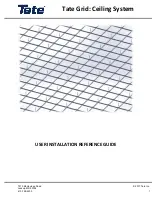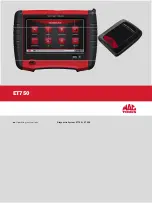
English
23
1
2
3
Fig. 13a
4
5
Fig. 13b
1) ON-OFF switch. - 2) USB pendrive port for PC
connection and to use the «WD2 Service tool wash»
program. - 3) USB pendrive port for inserting or
extracting the pre-filled programs. - 4) USB drive for
emergency release. - 5) Hole for emergency release.
6.2 Before use
The thermodisinfector can be used for cleaning and
disinfecting:
- Medical instruments.
- Keys, trays, containers.
- Hollow instruments, e.g. suction cannulas, fixing
them to the appropriate supports, using the suitable
adapters.
6.2.1 Emergency release
In the event of a blackout, or any other need in which it
becomes difficult to open the thermodisinfector door,
there is a manual emergency release that can only be
activated if the door cannot be opened normally.
d
HAZARD. If the emergency release is used
while a program is running, very hot water
and chemicals may leak. Therefore, there is a
danger of burns, scalding and irritation.
To access the emergency release:
- open the lower door of the machine with the key;
- remove the rubber cap (4 Fig. 13);
- a plastic cable can be seen inside the hole.
Simply pull this cable manually and the door is released.
Re-insert the cap after the operation.
In case of program interruption, proceed with a new
treatment of the load.
6.2.2 Preparing the load
a
WARNING. The maximum weight that
the open door can withstand is 12 Kg. The
maximum volume available is 0.065 m³ or
65 L. The maximum volume of the basket is
0.025 m³ or 25 L.
The instruments to be washed must be placed on the
relative basket, making sure that they do not overlap
one another.
- Empty any residual liquids from the instruments and
containers before inserting them in the tank, washing
all residues well, e.g. disinfectant solutions and in
cold water.
- Insert the individual instruments in the appropriate
supports or baskets and never directly into the base
basket.
- Make sure that the instruments do not come out of
the containers.
- Make sure that the instruments do not hang from the
grid bars.
- Insert the hollow instruments into the appropriate
injectors.
- Insert the other instruments into the adapters with
silicone insert.
- The rinse arms must be free to rotate.
- The cleaning quality depends on the correct loading
of the instruments.
- Position container-shaped objects so that liquids can
flow easily and, if possible, place tall and heavy tools
in the centre of the trolley.
- Components with special geometries must be
arranged so as to allow the water to flow out.
- Introduce only suitable steel instruments, resistant to
corrosion.
- Introduce only plastic components thermostable up
to 95°C.
- To prevent possible corrosion, we recommend using
only stainless steel instruments and tools, suitable for
washing.
- Nickel-plated and chrome-plated and/or aluminium
instruments and tools may not always be suitable
for machine treatment. They require special process
conditions.
















































